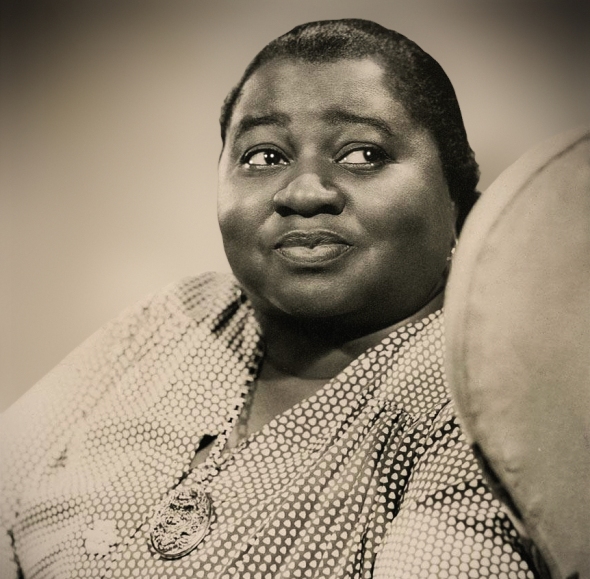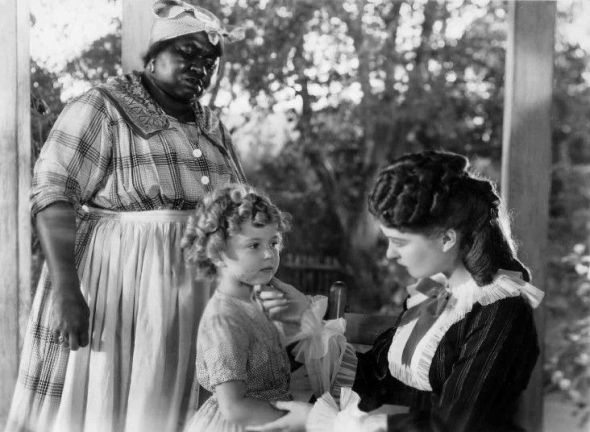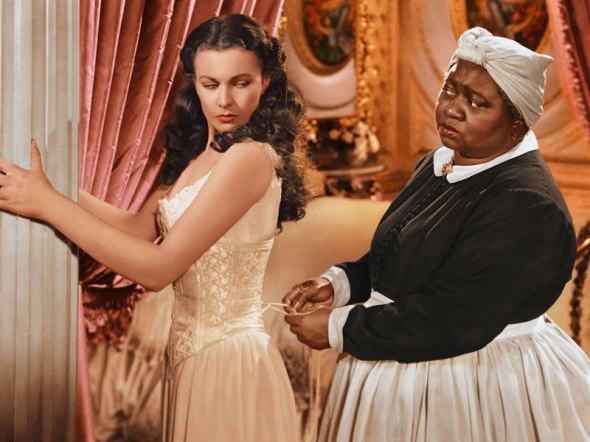Know Your Character Actor – Hattie McDaniel
Leave a commentAugust 14, 2016 by smumcounty


Henry McDaniel
Hattie McDaniel was born on June 10th, 1895 in Wichita Kansas. The youngest of thirteen children, her mother and father were both former slaves. Her father, Henry McDaniel, had fought in the Civil War and still suffered from wounds he had received in that conflict. Her mother, Susan Holbert, was singer of religious music who took on domestic work. In 1901, the family moved to Denver Colorado where Hattie attended the 24th Street Elementary School. She was one of only two black students in her class. Later when she attended the Denver East High School, Hattie demonstrated a flair for singing and started to sing and perform professionally in skits as part of the Mighty Minstrels. In 1909, she decided to leave school to work on her fledging performing career full time, writing songs and singing in her brother’s minstrel show. In 1916, her brother Otis died and the minstrel show began to lose money. From 1920 to 1925 she played in Professor George Morrison’s Melody Hounds, a black ensemble that toured the Vaudeville circuit. She appeared with the Melody Hounds and other Vaudeville troops for the next five years. In the mid-20’s, she started her radio career singing with the Melody Hounds in Denver on station KOA. From 1926 to 1929 she recorded many of her own songs with Okeh Records and Paramount Records of Chicago, including “Boo Hoo Blues” and “I Wish I Had Somebody”.

Hattie with Shirley Temple in “The Little Colonel” (1935)
The stock market crash of 1929 put an end to Hattie’s performing career. She was only able to get work as a washroom attendant and waitress at Club Madrid in Milwaukee until she was able to convince the club’s owner to let her sing in one of their stage shows. Shortly after, Hattie became a regular performer there. In 1932, she moved to Los Angeles to join her brother Sam and her sisters Etta and Orlena who had had some success procuring small film roles. Hattie started the hunt for film work as well and supplemented this with domestic work. Brother Sam was appearing on a KNX radio show, “The Optimistic Do-Nut Hour” and with Sam’s connection, Hattie was able to get a spot on the program, appearing as Hi Hat Hattie, a bossy maid who often forgot her place. The show was popular but the pay was so low that she still had to take work as a maid to make ends meet. In 1931, Hattie finally landed her first film role, appearing as an extra in a musical. A year later, she appeared in “The Golden West” (1932) as a housekeeper, a role which would define her career from here on. Hattie’s next film role was much more substantive, appearing in “I’m No Angel” (1933), Mae West’s first film, as Mae’s personal maid. Other small uncredited film roles followed in the early 30’s.

Hattie and Paul Robeson in “Show Boat” (1936)
Her first big role was in Fox’s “Judge Priest” (1934), directed by John Ford and starring Will Rogers. She had a major part in this film and even sang a duet with Rogers. Fox put her under contract after this film and next cast her in the Shirley Temple vehicle “The Little Colonel” (1935), also starring Lionel Barrymore and Bill Robinson. This role garnered her wide attention and she started getting a steady stream of parts after this. In 1935, she appeared as a slovenly maid in “Alice Adams” starring Katherine Hepburn and Fred MacMurray. Also in 1935, she played Jean Harlow’s personal maid in “China Seas” starring Harlow, Clark Gable, and Wallace Beery. During the filming of this film she and Gable began a friendship that would last a lifetime. She played Queenie in James Whale’s “Show Boat” (1936) starring Allan Jones and Irene Dunne. In this film, she was given the chance to show off her singing talents when she sang a verse of “Can’t Help Lovin’ Dat Man” with Dunne, Helen Morgan, and Paul Robeson. She also sang the duet “Ah Still Suits Me” with Paul Robeson.

Hattie with Clark Gable and Jean Harlow in “China Seas” (1935)
Hattie played a maid in “Saratoga” (1937), another Jean Harlow and Clark Gable teaming. She was also a maid in “Vivacious Lady” (1938) starring Jimmy Stewart and Ginger Rogers, and in “The Shopworn Angel” (1938) starring Jimmy Stewart and Margaret Sullavan. In “The Mad Miss Manton” (1938) with Barbara Stanwyck and Henry Fonda she played a housekeeper. In “Nothing Sacred” (1937), starring Carole Lombard and Frederic March, she broke the stereotype and played the wife of a bootblack.
When “Gone with the Wind” came along in 1939, you would think the casting of Mammy, the ultimate domestic worker would be a no brainer; Hattie should have been a shoe in. But competition for the role of Mammy was almost as stiff as for that of Scarlett O’Hara. Eleanor Roosevelt even wrote to producer David O. Selznick to ask that her maid, Elizabeth McDuffie, be given the part. Hattie was worried she might be passed over for the part since she was known up to then primarily as a comic actress, but she was determined to do her best and showed up to the audition dressed in a maid’s outfit thus securing the part.

Hattie and Vivien Leigh in “Gone with the Wind” (1939)
The premiere of “Gone with the Wind” was held at the Loew’s Grand Theater in Atlanta Georgia. Due to Georgia’s segregation laws, Hattie would not normally be allowed to attend this whites only theater. Selznick asked that an exception be made for Hattie but MGM, the film’s distributor, thought he had better not rock the boat. Clark Gable threatened to boycott the Atlanta opening unless Hattie was allowed to attend but Hattie convinced him to go anyway. In the end, Hattie was not allowed to attend the premiere in Atlanta but she did attend the Hollywood premiere and Selznick made sure that the program for the Hollywood premiere prominently featured Hattie.
 For her portrayal of Mammy, the strong-willed house slave who scolds Scarlett O’Hara and scoffs at the swaggering Rhett Butler, Hattie won the Academy Award for Best Supporting Actress beating out co-star Olivia de Havilland and becoming the first black to win an Oscar and the first black to be nominated. The Oscar win for Hattie was bittersweet for many blacks at the time. While they were happy to see one of their race receive this prestigious award, they thought it unfortunate that the role was in a film that glorified slavery and the plantation system of the old south and glossed over its injustices.
For her portrayal of Mammy, the strong-willed house slave who scolds Scarlett O’Hara and scoffs at the swaggering Rhett Butler, Hattie won the Academy Award for Best Supporting Actress beating out co-star Olivia de Havilland and becoming the first black to win an Oscar and the first black to be nominated. The Oscar win for Hattie was bittersweet for many blacks at the time. While they were happy to see one of their race receive this prestigious award, they thought it unfortunate that the role was in a film that glorified slavery and the plantation system of the old south and glossed over its injustices.
At the Oscar ceremonies in 1940 the specter of segregation again raised its ugly head. The awards were held at the Cocoanut Grove nightclub in the Ambassador Hotel which had a strict no blacks policy. Selznick had to pull strings to get her entrance into the building for the ceremony but then she was not allowed to sit at the Gone with the Wind table where Selznick sat with Vivien Leigh and Clark Gable. She was seated at a smaller table set off to the side with her escort and her agent. Even though treated as a second class citizen at this event, Hattie was gracious and moved to tears as she accepted her award, stating that she hoped she would always be a credit to her race and to the motion picture industry.

Hattie and Olivia de Havilland in “In This Our Life” (1942)
The 40’s saw Hattie playing more of the same kinds of roles she had played her entire career. In “In This Our Life” (1942) starring Bette Davis and and Olivia de Havilland, Hattie played a maid whose law student son is wrongly accused of murder. In “The Male Animal” (1942), starring Henry Fonda and Olivia de Havilland, she plays a maid, and in “Since You Went Away” (1944), an epic Selznick production about life on the home front during World War II, she also plays a maid. But these sorts of roles were becoming more controversial throughout the 40’s due to the Civil Rights Movement. Members of the progressive black community felt that Hattie’s appearance in films portraying characters that were subservient and happy to be so was detrimental to the burgeoning movement. The president of the NAACP, Walter White, pleaded with black actors to stop taking these roles and encouraged Hollywood studios to create roles for blacks that were more varied than just servants for white people.
 Over time, the kind of domestic servant roles that Hattie normally filled began to dwindle. Hattie reacted to this loss of film roles by turning once again to radio. In 1947, she accepted the title role in CBS Radio’s “The Beulah Show”. She was once again playing a maid but the NAACP was pleased to see a historic first: a black woman as the star of a network radio program. She then appeared in the television version of the show on ABC in 1951, replacing Ethel Waters after the first season. Waters left over concerns about stereotypes portrayed in the show. The show was indeed controversial. In 1951, the United States Army stopped broadcasting the show to its troops in Asia due to complaints from the troops that the show perpetuated negative stereotypes of black men being lazy and shiftless. Shortly after filming the first six episodes of Beulah, Hattie was diagnosed with breast cancer and had to leave the show. Eventually she became too ill to continue and she was replaced by Louise Beavers.
Over time, the kind of domestic servant roles that Hattie normally filled began to dwindle. Hattie reacted to this loss of film roles by turning once again to radio. In 1947, she accepted the title role in CBS Radio’s “The Beulah Show”. She was once again playing a maid but the NAACP was pleased to see a historic first: a black woman as the star of a network radio program. She then appeared in the television version of the show on ABC in 1951, replacing Ethel Waters after the first season. Waters left over concerns about stereotypes portrayed in the show. The show was indeed controversial. In 1951, the United States Army stopped broadcasting the show to its troops in Asia due to complaints from the troops that the show perpetuated negative stereotypes of black men being lazy and shiftless. Shortly after filming the first six episodes of Beulah, Hattie was diagnosed with breast cancer and had to leave the show. Eventually she became too ill to continue and she was replaced by Louise Beavers.

Memorial at the Hollywood Forever Cemetery
McDaniel died of breast cancer on October 26th, 1952, at the age of 57 in Woodland Hills, California. She had wished to be buried at the Hollywood Cemetery where the remains of other famous Hollywood stars like Rudolph Valentino and Douglas Fairbanks are interred. But, here too, even after death, Hattie had to contend with racial segregation. Hollywood Cemetery did not allow the interment of blacks at the time so her body was instead laid to rest in Angelus-Rosedale Cemetery in Los Angeles. In 1999, the new owner of the Hollywood Cemetery now renamed the Hollywood Forever Cemetery, Tyler Cassidy, offered to have her remains moved there but her family declined the offer. Instead a monument was erected in her honor at the cemetery overlooking the lake.
Trivia:
- In 2010, Mo’Nique, the winner of the Best Supporting Actress Oscar for her performance in “Precious” (2009), accepted the award wearing a blue dress with white gardenias in her hair just as Hattie had done when accepting her award. In her acceptance speech, Mo’Nique thanked Hattie “for enduring all that she had to so that I would not have to”.
- Hattie’s Oscar was bequeathed to Howard University after her death but the award went missing in the early 70’s. There are stories that angry black protesters, after the death of Dr. King, threw it into the Potomac, but W. Burlette Carter, a professor at George Washington Law School who undertook a yearlong investigation into the missing award, rejects this assertion. It is much more likely that the award simply went missing from Howard University’s archives due to inadequate recordkeeping.
Hattie and Paul Robeson sing “Ah Still Suits Me” in “Show Boat” (1936)
Vivien Leigh and Hattie in “Gone with the Wind” (1939)
Hattie winning Best Supporting Actress Oscar
Hattie and Ruby Dandridge in “The Beulah Show”
